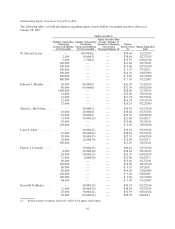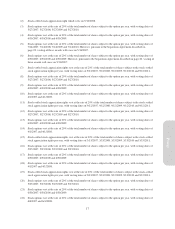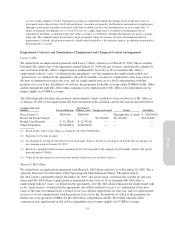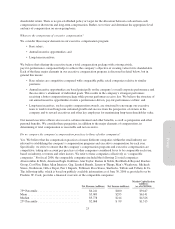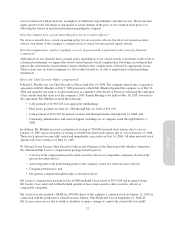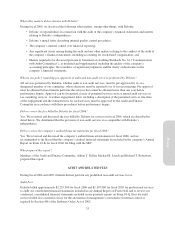Pottery Barn 2006 Annual Report Download - page 117
Download and view the complete annual report
Please find page 117 of the 2006 Pottery Barn annual report below. You can navigate through the pages in the report by either clicking on the pages listed below, or by using the keyword search tool below to find specific information within the annual report.
shareholder return. There is no pre-established policy or target for the allocation between cash and non-cash
compensation or short-term and long-term compensation. Rather, we review and determine the appropriate level
and mix of compensation on an on-going basis.
What are the components of executive compensation?
We consider three major elements in our executive compensation program:
• Base salary;
• Annual incentive opportunities; and
• Long-term incentives.
We believe that offering the executive team a total compensation package with a strong at-risk,
pay-for-performance component helps to achieve the company’s objective of creating value for its shareholders.
Each of the three major elements in our executive compensation program is discussed in detail below, but in
general this means:
• Base salaries are competitive compared with comparable public retail companies relative to similar
positions;
• Annual incentive opportunities are based principally on the company’s overall corporate performance and
the executive’s attainment of individual goals. This results in the company’s strongest performers
receiving a better compensation package while poorer performers receive less. We believe the structure of
our annual incentive opportunities fosters a performance-driven, pay-for-performance culture; and
• Long-term incentives, such as equity compensation awards, are structured to encourage our executive
team to work toward long-term sustained growth and success from the perspective of owners in the
company and to reward executives and other key employees for maximizing long-term shareholder value.
Our named executive officers also receive certain retirement and other benefits, as well as perquisites and other
personal benefits. We consider these perquisites, in addition to the major elements of compensation, in
determining if total compensation is reasonable and not excessive.
Do we compare the company’s compensation practices to those of other companies?
Yes. We believe that the compensation practices of many different companies within the retail industry are
relevant to establishing the company’s compensation programs and executive compensation for each year.
Specifically, we strive to ensure that the company’s compensation programs and executive compensation are
competitive, taking into account pay practices at other companies considered by us to be comparable each year,
based on industry, revenues and other factors. We refer to these companies collectively as “comparable
companies.” For fiscal 2006, the comparable companies included the following 21 retail companies:
Abercrombie & Fitch, American Eagle Outfitters, Ann Taylor, Barnes & Noble, Bed Bath & Beyond, Borders
Group, Cost Plus, Ethan Allen Interiors, Gap, Limited Brands, Linens-n-Things, Men’s Wearhouse, Michaels
Stores, Nordstrom, Office Depot, Pier 1 Imports, PetSmart, Ross Stores, Starbucks, Talbots and Tiffany & Co.
The following table, which is based on publicly available information as of June 30, 2006 as provided to us by
Frederic W. Cook, provides a financial overview of the comparable companies:
Net Revenue (millions) Net Income (millions)
Market Capitalization
(millions)
(as of 6/30/2006)
75th Percentile ............................ $6,241 $400 $9,447
Mean ................................... $5,009 $293 $6,141
Median ................................. $3,778 $214 $4,326
25th Percentile ............................ $2,068 $ 99 $1,515
23
Proxy





